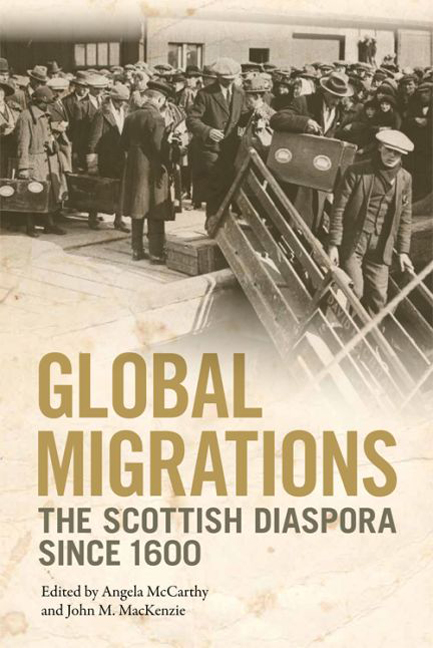Book contents
- Frontmatter
- Contents
- List of Figures and Tables
- Notes on the Contributors
- Acknowledgements
- A Tribute to Sir Tom Devine
- 1 Introduction-Global Migrations: The Scottish Diaspora since 1600
- 2 ‘As Hewers of Wood, and Drawers of Water’: Scotland as an Emigrant Nation, c. 1600 to c. 1800
- 3 ‘You Have Only Seen the Fortunate Few and Draw Your Conclusion Accordingly’: Behavioural Economics and the Paradox of Scottish Emigration
- 4 Scottish Diasporas and Africa
- 5 ‘Have the Scotch no Claim upon the Cherokee?’ Scots, Indians and Scots Indians in the American South
- 6 Conflicts of Interest, Crises of Conscience: Scots and Aboriginal People in Eastern Australia, 1830s–1861
- 7 The Importance of Scottish Origins in the Nineteenth Century: James Taylor and Ceylon Tea
- 8 ‘Our Old World Diff'rences are Dead’: The Scottish Migrant Military Tradition in the British Dominions during the First World War
- 9 ‘Part of my Heritage’: Ladies’ Pipe Bands, Associational Culture and ‘Homeland’ Identities in the Scottish Diaspora
- 10 Understanding Scottishness among Sojourners, Settlers and Descendants in Hong Kong and New Zealand
- 11 Encountering an Imaginary Heritage: Roots Tourism and the Scottish Diaspora
- 12 Home is where the Heart is: Affinity Scots in the Scottish Diaspora
- 13 What Scottish Diaspora?
- 14 Afterword
- Index
11 - Encountering an Imaginary Heritage: Roots Tourism and the Scottish Diaspora
Published online by Cambridge University Press: 23 September 2017
- Frontmatter
- Contents
- List of Figures and Tables
- Notes on the Contributors
- Acknowledgements
- A Tribute to Sir Tom Devine
- 1 Introduction-Global Migrations: The Scottish Diaspora since 1600
- 2 ‘As Hewers of Wood, and Drawers of Water’: Scotland as an Emigrant Nation, c. 1600 to c. 1800
- 3 ‘You Have Only Seen the Fortunate Few and Draw Your Conclusion Accordingly’: Behavioural Economics and the Paradox of Scottish Emigration
- 4 Scottish Diasporas and Africa
- 5 ‘Have the Scotch no Claim upon the Cherokee?’ Scots, Indians and Scots Indians in the American South
- 6 Conflicts of Interest, Crises of Conscience: Scots and Aboriginal People in Eastern Australia, 1830s–1861
- 7 The Importance of Scottish Origins in the Nineteenth Century: James Taylor and Ceylon Tea
- 8 ‘Our Old World Diff'rences are Dead’: The Scottish Migrant Military Tradition in the British Dominions during the First World War
- 9 ‘Part of my Heritage’: Ladies’ Pipe Bands, Associational Culture and ‘Homeland’ Identities in the Scottish Diaspora
- 10 Understanding Scottishness among Sojourners, Settlers and Descendants in Hong Kong and New Zealand
- 11 Encountering an Imaginary Heritage: Roots Tourism and the Scottish Diaspora
- 12 Home is where the Heart is: Affinity Scots in the Scottish Diaspora
- 13 What Scottish Diaspora?
- 14 Afterword
- Index
Summary
The poetry of history lies in the quasi-miraculous fact that once, on this earth, on this familiar spot of ground, walked other men and women, as actual as we are today, thinking their own thoughts, swayed by their own passions, but now all gone, one generation vanishing into another[.]
AROUND THE WORLD, SOME 40 million people claim Scottish ancestry. Every year thousands of members of the Scottish diaspora travel to their imagined homeland. They come to Scotland to experience the culture of their ancestors and to walk in the places where their forebears walked. They come to Scotland because, like many diasporic populations around the globe, they imagine that their home is somewhere other than in the place they reside, and they travel in order to connect with their roots. Scotland is, of course, not the only country with a strong tradition of roots tourism. Cultural heritage trips, in which participants seek out an embodied experience of culture and connection, are part of a growing global fascination with heritage and genealogy. Nations with significant migration histories, including Israel and China, have, like Scotland, recognised the power inherent in their global communities and actively promote heritage tourism programmes.
Coming from distinctive ethnic traditions and migration histories, roots tourists in these different national contexts are united by their identity relationship to the homeland as a place. According to Paul Basu, the homeland is ‘situated at the centre of diasporic consciousness, anchoring it spatially and temporally’. Unlike some diasporic populations, most global Scots are several generations removed from the migration process (if they have any tangible genealogical connection at all), so they have no first-hand experience of place. They therefore imaginatively construct Scotland through family traditions, material culture and society and clan gatherings. Scotland is nostalgically imagined as a place of living history and a land lost in time, or in the words of G. M. Trevelyan, a ‘familiar spot of ground’ connecting them to past generations. The imagined Scotland is dominated by a romanticised Highland landscape punctuated by images of clans, castles, tartan and bagpipes. The individual's own relationship to that space is conceptualised through narratives of Clearance that may have very little basis in academic historical understandings of Scotland's past.
- Type
- Chapter
- Information
- Global MigrationsThe Scottish Diaspora since 1600, pp. 199 - 218Publisher: Edinburgh University PressPrint publication year: 2016



